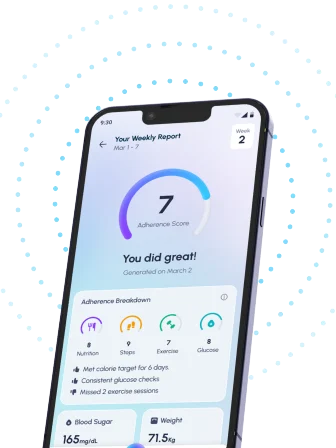Table of Contents
- Mastering Breathwork for Diabetes Control
- Diabetes Management: The Power of Breath
- Improve Blood Sugar with Breath Control Techniques
- Respiratory Exercises for Better Diabetes Management
- Is Breath Control a Useful Tool for Diabetes?
- Frequently Asked Questions
- References
Living with diabetes often feels like navigating a tightrope walk, balancing diet, medication, and activity levels. But what if I told you there’s a powerful, often overlooked tool that can significantly improve your blood sugar control and overall well-being? This blog post is all about Mastering Breath Control: A Diabetes Management Guide. We’ll explore simple yet effective breathing techniques that can help reduce stress, improve insulin sensitivity, and even manage those frustrating blood sugar spikes. Ready to discover a surprisingly simple yet profound way to take charge of your health? Let’s dive in!
Mastering Breathwork for Diabetes Control
Did you know that individuals with diabetes face a 70% higher risk of sleep apnea and other sleep disorders? This alarming statistic highlights a crucial connection between respiratory health and diabetes management, often overlooked in tropical and Indian climates where heat and humidity can further exacerbate breathing difficulties. Mastering breath control techniques, therefore, becomes an essential element of holistic diabetes management in these regions.
The Power of Pranayama for Diabetes
Many traditional Indian breathing exercises, or pranayama, offer practical benefits for diabetics. Techniques like Dirga Pranayama (three-part breath) can improve lung capacity and oxygen intake, potentially mitigating the effects of sleep apnea and improving overall energy levels. Bhramari Pranayama (bee breath) can help reduce stress and anxiety, known contributors to blood sugar fluctuations. Regular practice of these techniques can contribute to better blood glucose control and improved sleep quality, crucial aspects of managing diabetes. For more comprehensive strategies, check out 10 Proven Tips for Effective Diabetes Management.
Practical Tips for Breathwork in Hot Climates
In hot and humid climates prevalent across India and other tropical regions, practicing breathwork requires careful consideration. Choose cooler times of the day, such as early morning or late evening, for your practice. Ensure adequate hydration before, during, and after each session. Listen to your body – if you feel overwhelmed by heat or discomfort, stop and resume later. Consider practicing in a well-ventilated area or using a fan.
Integrating Breathwork into Your Diabetes Management Plan
Incorporating breathwork into your daily routine can significantly enhance your overall well-being and diabetes management. Combine these techniques with a healthy diet, regular exercise, and medication as prescribed by your doctor for optimal results. Consult with your healthcare professional or a qualified yoga instructor to learn proper techniques and adapt them to your individual needs and the specific challenges of your climate. Remember, breath control is a powerful tool, readily accessible and highly beneficial for managing diabetes, particularly in the unique context of tropical and Indian environments. Remember that a Personalized Diabetes Control plan can significantly improve your outcomes, incorporating breathwork and other lifestyle factors.
Diabetes Management: The Power of Breath
Managing diabetes effectively requires a holistic approach, and often overlooked is the power of breath control. For the 61% of people with diabetes aged between 20-64, and the 39% aged 65+, incorporating simple breathing techniques can significantly improve overall well-being. This is particularly relevant in hot and humid climates prevalent across India and other tropical countries, where managing blood sugar levels can be more challenging.
Stress Reduction and Blood Sugar Control
Stress is a known trigger for blood sugar spikes. Deep, controlled breathing exercises, such as pranayama (common in Indian practices), can help reduce stress hormones, promoting better blood sugar regulation. Techniques like alternate nostril breathing (Nadi Shodhana) or diaphragmatic breathing can be easily incorporated into daily routines. Practicing these techniques several times a day can lead to noticeable improvements in stress levels and blood sugar control.
Improved Insulin Sensitivity
Studies suggest that mindful breathing practices can enhance insulin sensitivity. Improved insulin sensitivity means your body utilizes insulin more effectively, leading to better glucose management. Regular practice of breathing exercises, combined with a healthy diet and regular exercise, can significantly improve your overall diabetic health. This is crucial, especially in regions with limited access to advanced medical care.
Boosting Energy Levels
Managing diabetes can be exhausting, both physically and mentally. Breathing exercises can help increase energy levels by improving oxygen intake and reducing feelings of fatigue. In hot and humid environments, this is particularly beneficial as fatigue can exacerbate diabetes management challenges. Prioritize finding a quiet space for your breathing exercises, especially during the hottest parts of the day. For those facing the specific challenges of managing diabetes as they age, Managing Diabetes as You Age: Challenges and Solutions offers valuable insights and strategies.
Actionable Steps for Better Diabetes Management
Start with just 5-10 minutes of daily breathing exercises. Gradually increase the duration as you become more comfortable. Consult your doctor or a qualified healthcare professional before starting any new wellness program, especially if you have any underlying health conditions. Remember, consistent practice is key to experiencing the benefits of breath control in managing your diabetes effectively. Seek out local resources and support groups in your community to stay motivated and connected. Learn more about diabetes statistics worldwide. For more simple yet effective tips, check out 10 Proven Tips to Effectively Manage Diabetes | Simple Guide.
Improve Blood Sugar with Breath Control Techniques
Managing diabetes effectively in hot and humid climates like those prevalent in India and other tropical countries presents unique challenges. Maintaining optimal blood sugar levels, generally aiming for below 140/90 mmHg or even below 130/80 mmHg as some guidelines suggest, is crucial. While medication and diet are cornerstones of diabetes management, incorporating breath control techniques can significantly contribute to better blood sugar regulation and overall well-being.
The Power of Pranayama
Many ancient Indian breathing exercises, collectively known as pranayama, offer potential benefits for diabetes management. These techniques focus on regulating the breath, which in turn can influence the autonomic nervous system, impacting stress levels and potentially improving insulin sensitivity. Practices like Nadi Shodhana (alternate nostril breathing) and Ujjayi (victorious breath) are particularly accessible and can be easily incorporated into a daily routine. Regular practice can help reduce stress, a known factor in blood sugar spikes.
Practical Application and Regional Considerations
Incorporating pranayama into your daily life requires consistency. Start with short sessions (5-10 minutes) twice a day, gradually increasing the duration as you become more comfortable. The heat and humidity of tropical climates might initially make deep breathing feel challenging, so it’s important to practice in a well-ventilated area and stay well-hydrated. Remember, breath control is a complementary therapy and shouldn’t replace prescribed medication or dietary advice from your doctor. Consult with your physician or a qualified yoga instructor before starting any new breathing exercises, especially if you have pre-existing health conditions.
Taking Charge of Your Health
By combining traditional Indian practices like pranayama with a healthy diet and regular exercise, you can significantly improve your diabetes management and enhance your overall quality of life. Take control of your health today – your body will thank you for it! For more information on establishing helpful habits, check out How to Build Habits That Help Control Blood Sugar Levels. Scheduling a consultation with your doctor to discuss incorporating breath control techniques into your personalized diabetes management plan is also recommended. In addition to breathwork, exploring Top 8 Natural Remedies to Improve Blood Sugar Levels might further support your efforts.
Respiratory Exercises for Better Diabetes Management
Managing diabetes effectively is crucial, especially in hot and humid climates prevalent across India and other tropical countries. Studies show that complications are exacerbated by pre-existing conditions, with smokers with diabetes facing a doubled mortality risk from cardiovascular issues. Improving respiratory function through dedicated exercises can significantly contribute to better overall health and diabetes management in these regions.
Pranayama and Diaphragmatic Breathing
Traditional Indian breathing techniques like pranayama offer a powerful approach to improving lung capacity and reducing stress, both vital for effective diabetes management. Diaphragmatic breathing, a key element of pranayama, helps regulate blood sugar levels by promoting relaxation and reducing insulin resistance. Practicing deep, slow breaths throughout the day can significantly impact your well-being.
Simple Exercises for Improved Lung Function
Incorporating simple respiratory exercises into your daily routine can yield substantial benefits. Try these: Belly breathing (placing a hand on your abdomen to monitor its rise and fall with each breath), pursed-lip breathing (exhaling slowly through pursed lips to clear airways), and alternate nostril breathing (Nadi Shodhana in pranayama) to balance energy and calm the nervous system. Remember to consult your doctor before starting any new exercise regime, especially if you have pre-existing conditions like diabetes or heart problems. For a deeper understanding of how diabetes impacts your respiratory system, read our article on How Does Diabetes Affect the Respiratory System?
Making it a Habit in Tropical Climates
The heat and humidity of tropical regions can impact breathing, making consistent practice even more important. Find a cool, well-ventilated space for your exercises. Consider incorporating these exercises into your morning or evening routine, making it a regular habit to see lasting results in your diabetes management. Remember, consistent effort is key to reaping the benefits of these techniques. Prioritizing your respiratory health is a crucial step in managing diabetes effectively, particularly in challenging climates. And remember that respiratory exercises are just one part of a holistic approach; Why Regular Exercise is Essential for Diabetes Management also highlights the importance of overall physical activity.
Is Breath Control a Useful Tool for Diabetes?
The staggering statistic that up to 80% of Type 2 diabetes cases can be delayed or prevented through lifestyle changes highlights the crucial role preventative measures play. While medication and diet are cornerstones of diabetes management, exploring complementary approaches like breath control techniques offers potential benefits, particularly in hot and humid climates prevalent in India and other tropical countries.
The Link Between Breath and Blood Sugar
Deep, controlled breathing, such as pranayama techniques from yoga, can influence the autonomic nervous system, impacting stress levels and potentially improving insulin sensitivity. Stress is a known trigger for blood sugar spikes, and managing stress through breathwork may be a valuable tool. Furthermore, mindful breathing can promote relaxation, encouraging healthier lifestyle choices often associated with better diabetes management. This is particularly relevant in regions where heat and humidity can exacerbate stress levels. Understanding how diabetes affects blood flow is also crucial, as stress can impact circulatory health.
Practical Breathwork for Diabetes Management
Incorporating simple breathing exercises into your daily routine can be incredibly beneficial. Try practicing diaphragmatic breathing (belly breathing) for 5-10 minutes several times a day. Focus on slow, deep inhales and exhales, feeling your abdomen rise and fall. Alternatively, explore guided meditation apps or consider joining a local yoga class—a popular and accessible practice across India and other tropical regions. Managing blood sugar effectively also involves attention to other health factors, such as how to manage cholesterol levels with diabetes.
Beyond Breath: A Holistic Approach
Breath control is not a standalone solution for diabetes management. It’s a complementary strategy that works best when integrated with a balanced diet, regular exercise, and consistent medical supervision. Consult your doctor or a certified diabetes educator to determine the best approach for your individual needs, considering your specific climate and lifestyle. Remember, a holistic approach combining modern medicine with traditional practices can lead to better overall health and improved diabetes management.
Frequently Asked Questions on Breath Control
Q1. What is breath control and how can it help manage diabetes?
Breath control techniques, such as pranayama from traditional Indian practices, may offer complementary benefits for diabetes management. These techniques improve lung capacity, oxygen intake, and stress reduction, which can potentially help mitigate sleep apnea, boost energy levels, and regulate blood sugar.
Q2. What are the benefits of using breath control for diabetes?
Practicing breathwork may lead to several benefits, including improved lung capacity, increased oxygen intake, reduced stress, better sleep (by mitigating sleep apnea), increased energy levels, and potentially better blood sugar regulation. However, it’s crucial to remember that it is a complementary therapy, not a replacement for standard medical care.
Q3. Are there any considerations or precautions I should take when practicing breath control for diabetes?
Yes, environmental factors play a role. It is best to practice breathwork in cooler environments and ensure you are adequately hydrated. Always consult your doctor or a qualified yoga instructor for personalized guidance to safely integrate breathwork into your diabetes management plan.
Q4. How should I incorporate breath control into my existing diabetes management plan?
Breath control techniques should complement, not replace, your existing medical advice, diet, and exercise plan. Consult your healthcare provider and/or a qualified yoga instructor to determine the best way to safely and effectively incorporate breathwork into your holistic diabetes management strategy.
Q5. Can breath control techniques cure or completely replace other treatments for diabetes?
No, breath control techniques are a complementary therapy and should not replace medical advice, prescribed medications, proper diet, or regular exercise. It is crucial to continue with your existing diabetes management plan under the guidance of your healthcare professional.
References
- A Practical Guide to Integrated Type 2 Diabetes Care: https://www.hse.ie/eng/services/list/2/primarycare/east-coast-diabetes-service/management-of-type-2-diabetes/diabetes-and-pregnancy/icgp-guide-to-integrated-type-2.pdf
- Your Guide to Diabetes: Type 1 and Type 2: https://www.niddk.nih.gov/-/media/Files/Diabetes/YourGuide2Diabetes_508.pdf




